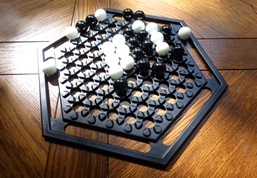After the “official” rule for 3 players, here is the “official” rule for 4 players, from the same board game box: Abalone+ multiplayers.
FightClub
°°°°°°
THE 4-PLAYER GAME
This variant opposes two teams of two players. Each player has nine marbles, disposed as shown on the diagram 1.
Any communication between players of the same team is strictly forbidden.
GOAL OF THE GAME
The goal of the game for each team is to push six marbles of the opposite team out of play, into the board’s outer rim. The ejected marble can belong to one opponent or the other.
THE MOVES
They are exactly the same as those of the 2-player rule. Each player can move in a same time 1, 2, or 3 of his marbles to a free point. All the directions are possible, forward, backward (“inline moves”), and even laterally (“side-step moves”).
You are not allowed to push more than 3 marbles of your colour in the same time. Marbles over 3 are not considered, so it is impossible to have Sumitos of 4 against 3, 5 against 2, etc. The maximum marbles of your colour which can be moved is 3.
THE PUSHING MOVES
You can push opponents’ marbles if you are in a Sumito position, as shown on the diagram 2:
2 marbles of the same team can push 1 marble of the opponent team.
3 marbles of the same team can push 1 marble of the opponent team.
3 marbles of the same team can push 2 marbles of the opponent team.
To make a Sumito, to can count the marbles (1 or 2) of your partner, but the first marble has to belong to you. You can push 2 marbles of the opponent team regardless of their colour.
THE EJECTIONS
A marble is ejected when a push make it go out of the board by any of the 6 sides of the hexagon, as shown on the diagram 3:
Please note that the first team who pushed off 6 marbles of the other team wins the game.
























